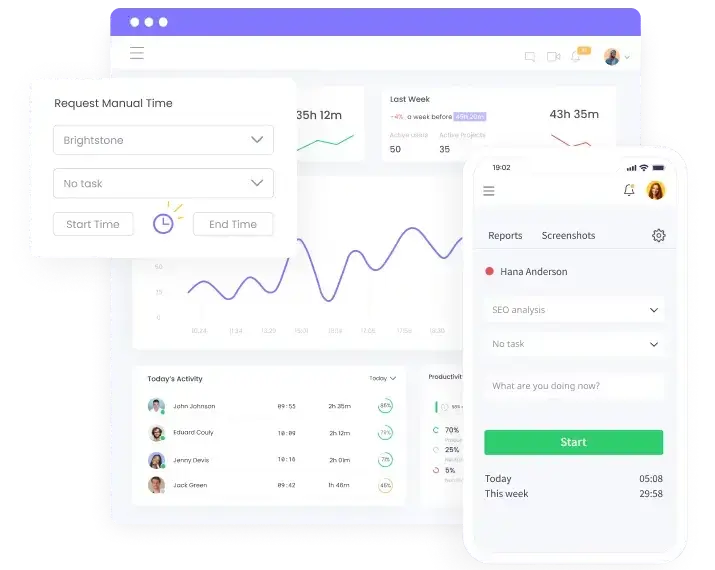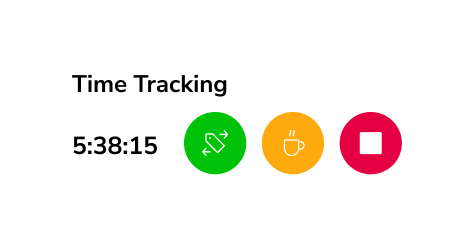This Review Covers:
- Overview
- What Do Users Like About WebWork?
- What Don’t Users Like About WebWork?
- What Pricing Plans Does WebWork Offer?
- What are the Standout Features of WebWork?
- Selected Positive User Feedback
- Selected Negative User Feedback
- What are WebWork’s Ratings from Review Sites?
- What’s My Final Verdict on WebWork?
Overview
WebWork is a versatile time tracking and employee monitoring software, with a desktop app, a mobile app, and a Chrome extension.
The software is compatible with Windows, macOS, and Linux. It also currently integrates with over 20 communication, management, and payroll platforms such as Slack, PayPal, Asana, and Xero. While several, its integration options are still limited compared to some market leaders, which typically offer 100+ choices.
Webwork’s time tracking system allows users to track time with detailed time reports, edit timesheets, request approvals, as well as schedule shifts.
The time tracking feature is fairly easy to use. A key concern however, is WebWork’s tendency to randomly stop tracking time, even when the user is still working on a task. This can really affect reporting accuracy and productivity evaluations. Some users have also reported glitches that result in lost time data.
On a positive note, WebWork enables productivity monitoring through features like screenshot monitoring on desktop, as well as GPS and activity level tracking. It even has app and website usage tracking, which allows managers to monitor the apps and websites employees use during work hours.
The software also offers payroll and invoicing features that complement its time tracking capabilities. This includes payroll reports that can be exported for payment gateways, in-built invoicing, customizable invoices, and invoice exporting and sharing.
Staff leave can also be managed through the software.
Another thing I find cool about WebWork is that it offers its own chat app, which is built-in or can be downloaded separately for desktop and mobile.
WebWork also boasts itself as an AI-powered time tracking software. But let’s be honest—AI still has its limits. It can crunch numbers, but it won’t know that Jamie missed a deadline because of an undocumented change in schedule. So for now, it’s more of a data whisperer than an accurate indicator of performance quality.
That’s not to say it isn’t useful. Sure, ask it a question or two to get a better idea of your team’s performance, but don’t expect it to replace your HR overnight!
-
Photo from WebWork
What Do Users Like About WebWork?
- Detailed productivity reporting
- Customizable invoicing
- Quality customer support
- User-friendly interface
What Don't Users Like About WebWork?
- Occasional bugs and glitches when tracking time
- Syncing delays with spotty internet
- Goes into idle mode when taking calls or meetings
- Intrusive at times
What Pricing Plans Does WebWork Offer?
WebWork offers three pricing plans: Pro, Plus, and Premium. Each plan is designed to meet different needs depending on your team’s size and workflow. As you move up the tiers, you get access to more advanced features.
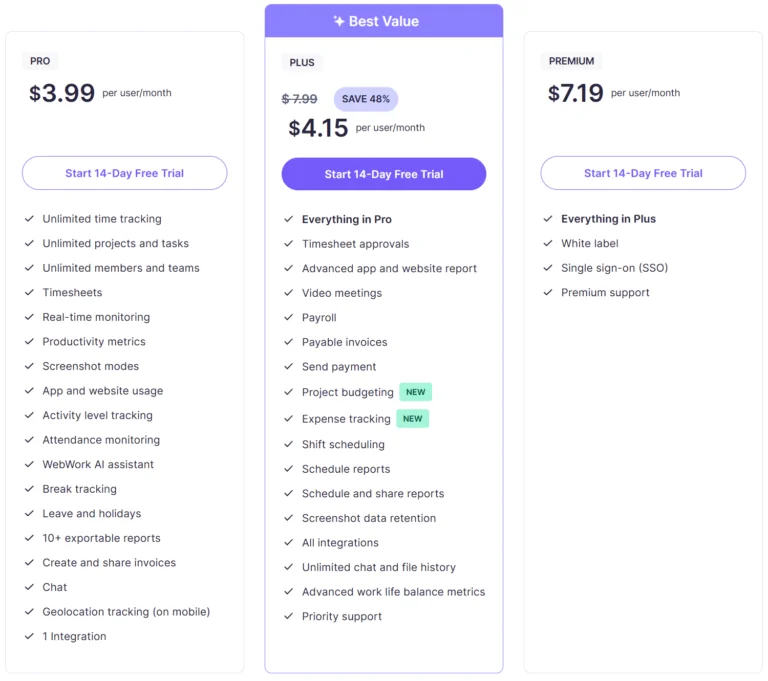
Photo from WebWork
Feature-wise, I think WebWork’s lineup is pretty comprehensive. The Pro plan is generous and has the key features for productivity and time tracking down, like activity level tracking, screenshots, and app and website usage.
Compared to its competitors, WebWork’s pricing isn’t the most expensive on the market, however, it is also not the cheapest. You can save on subscription fees if you opt for annual billing, but those who like the flexibility of a rolling monthly contract will have to pay 25% more.
WebWork also has no free plan, which may put some users off, particularly when some popular alternatives like Clockify offer one. However, it does offer a 14-day free trial for all pricing tiers, allowing users to experience the platform before deciding whether it’s worth the investment or not.
What are the Standout Features of WebWork?
1. Multi-platform Time Tracking
If you’re managing multiple teams in different locations with different demands, you need flexibility. The good thing about WebWork is the number of platforms it works across. Web, desktop app, mobile app, and a Chrome extension—it’s all there.
It’s worth noting, however, that the availability of features varies across platforms. For example, the Web app and the Chrome extension only offer time tracking capabilities, while screenshots and activity tracking are exclusive to the Desktop App. The screenshots taken can’t be accessed without the Desktop App.
Also, geolocation tracking is only available on the mobile app. However, users can access geolocation reports from a desktop device.
-
Photo from WebWork
2. Employee Monitoring
WebWork offers comprehensive employee monitoring tools that are not subtle. With features like screenshots, app tracking, and website logs, the software provides minute-by-minute activity tracking for employers.
The screenshot monitoring feature can be set to capture one to ten regular or blurred screenshots at a 10-minute interval, with the option to receive a notification every time a picture is taken. Users can disable screenshots but continue activity tracking for certain tasks. To safeguard data, WebWork has backed this feature with a multi-step encryption system.
In addition to screenshots, WebWork tracks web and app usage. Employers can even label websites and apps as productive, non-productive, or neutral. If a user spends time on a non-productive app, WebWork’s automated reminders can help them stay focused.
WebWork’s employee GPS tracking allows managers to view the routes employees take to work. The feature is only available on mobile though, and only functions when the permission is enabled in the settings. This includes tracking even when the mobile app is not in use, as long as background location tracking is enabled.
How users can benefit from these features will really come down to their management style. This level of employee monitoring can easily feel invasive so I’d say roll them out transparently and with caution.
Read more on how to roll out time tracking software effectively to help you build trust and get your team on board.
Photo from WebWork
3. Invoicing and Payroll
WebWork’s invoicing feature allows users to create customizable and personalized project or hour-based invoices using time tracking within the software. These invoices can then be exported and directly shared with clients.
The software’s payroll feature, on the other hand, allows for setting billable rates, generating automated payroll reports, as well as processing employee payments. This can be done through WebWork’s Deel integration, where timesheets are automatically sent to Deel based on selected pay periods.
Alternatively, managers can export payroll reports in formats compatible with payment gateways like Wise, PayPal, Payoneer, and Gusto. These reports can be uploaded to the payment system for payment processing, either individually or in bulk, with supportive features like paid overtime, paid time off, and automation.
Direct payments to employees can also be made through Stripe, Bitwage, and Wise with payment tracking.
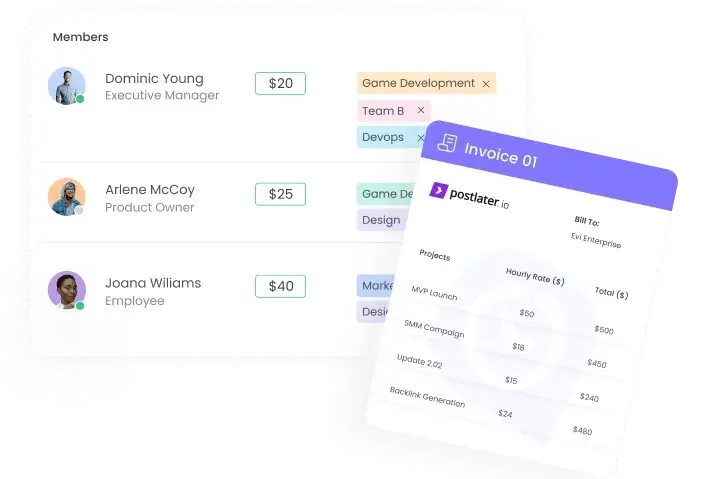
Photo from WebWork
4. Reporting
WebWork can generate a wide range of reports to give business insights into employee productivity.
There are web and app usage reports to gain a clearer understanding of how employees are spending their time. This data can be used to generate detailed productivity reports powered by WebWork AI.
There are also attendance reports that highlight working hours, tardiness, hour deficits, and shift assignments. To drill down to the data you need, you can filter reports by project, employee, or contract. It’s also great that you can visualize them through easy-to-understand pie, line, or bar charts.
Additionally, WebWork’s time reports show time spent on specific applications and websites over chosen periods (daily, weekly, or monthly). For a deeper dive, advanced reports even capture mouse, scroll wheel, and keyboard activity within apps.
If location tracking is important to your operations, WebWork also offers geolocation reports. These can be accessed directly from the dashboard on both mobile and desktop devices, helping you monitor where work is happening in real time.
You can schedule reports to be sent by email for regular updates and export them in CSV, XLS, or PDF formats for easy sharing or further analysis.
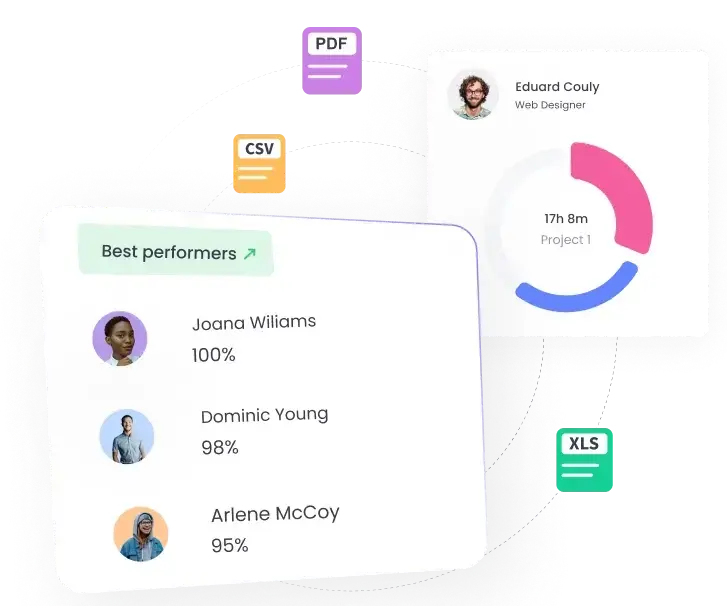
Photo from WebWork
5. Team Chat and Video Meetings
Not a lot of time tracking software has a chat feature, Webwork stands out in this regard. Their Chat app allows you to send messages or discuss in dedicated as well as general channels. Messages can be edited or deleted at any time.
WebWork Chat is accessible from within the software or separately on Windows, macOS, and Linux. It can also be downloaded from the App Store and Google Play.
The chat is protected with encryption algorithms and supports quick sharing of pictures, text documents, PDFs, spreadsheets, and presentations via drag and drop up to 50MB in size. It’s all pretty convenient for streamlining team communication.
Another great thing about Webwork is that you can set video meetings in online workspaces via personal rooms. Screen sharing is also available, and scheduled calls will appear on users’ dashboards.
One downside of this feature though, is that people outside of the workspace can only join video meetings if they are invited as Project Viewers first.
WebWork’s chat and video features aren’t meant to compete with Slack or Zoom—and that’s okay. It’s simple to use and meets your basic team communication needs. Plus, it’s just overall convenient to have everything in one place.
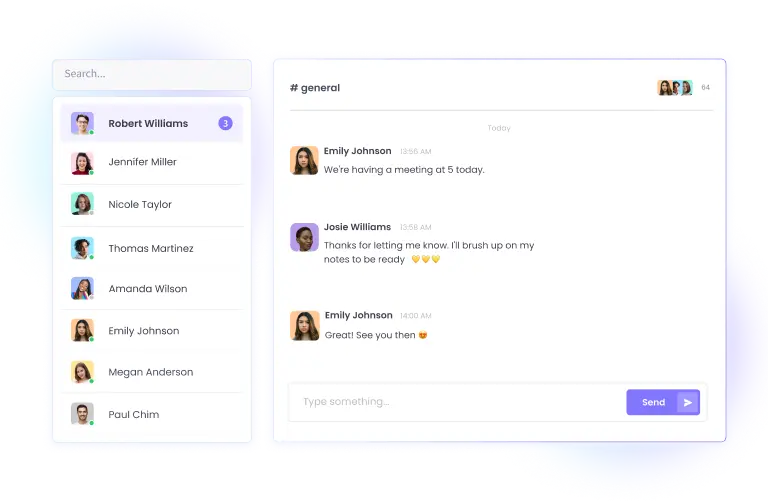
Photo from WebWork
Selected Positive User Feedback
- “Accurate time tracking, and great analytics and insights to track performance and productivity. I like the occasional reminders too.” – Jan (Source: Capterra)
- “What I liked most about WebWork Time Tracker is its simplicity and effectiveness in tracking time and productivity. The interface is user-friendly, making it easy for teams to monitor work hours, tasks, and even take screenshots for better accountability.” – Luiz (Source: Capterra)
- “The most helpful about using time tracker is that if you close the browser tab by accident, it doesn’t stop tracking your time, if you forget to clock out or stop the time tracker, it sends you an email warning you that you forgot it. It’s really user friendly.” – Ritta N. (Source: G2)
- “I value its accurate time tracking and screenshot capability, which facilitates efficient workflow monitoring. It is an excellent tool for increasing productivity, and its intuitive interface just makes it better.” – Dev I. (Source: G2)
- “Webwork Tracker Tracks the working time of the employee in an organization automatically and provides complete analytics. It has a clean dashboard to check the tracked data by employees and employers. As it runs in the background, it won’t disturb our work. It even provides the data like number of keyboard clicks, mouse clicks, and scrolls. Also, it captures a screenshot every 10 minutes and displays the data related to that screenshot. They have good Customer support and resolve any issue in a very short time. It helps employers to Calculate the salary based on the hours worked/Tracked.” – Venkata Midhun J. (Source: G2)
Selected Negative User Feedback
- “WebWork Time Tracker is that it can sometimes feel a bit intrusive, especially with features like automatic screenshots and activity monitoring. While these features are useful for tracking productivity, they might make some users feel like they’re being micromanaged. Additionally, the time tracking process can be a little rigid for some workflows, particularly if you’re working on multiple projects or tasks at once and want more flexibility.” – Honey J. (Source: G2)
- “WebWork could be better if there was an “Break” button instead of just clocking out during my shift.” – Verified User (Source: G2)
- “There is no reminder that you would need to update it when they have new updates. Sometimes you would have to find out the hard way, like when it glitches and you need to check if it’s up-to-date.” – Roccini R. (Source: G2)
- “Sometimes the website glitches and doesn’t update properly.” – Camila (Source: Software Advice)
- “the idle time when it goes off every 8 mins, at times when you are in a meeting or call it goes to your unproductive time.” – Leodigario (Source: Software Advice)
- “Whenever there is an issue with our internet connection or having a new update, It automatically stops tracking without any indication or intimation. With this issue, I have lost lots of Working hours. This is the only I’m facing and except that everything is fine.” – Venkata Midhun J. (Source: G2)
What are WebWork's Ratings from Review sites?
As of April 2025
- Capterra: 4.5/5
- Software Advice: 4.5/5
- GetApp: 4.5/5
- G2: 4.8/5
- Trustpilot: 4.8/5
- AppStore: 3.8/5
What's my Final Verdict on WebWork?
To conclude, WebWork has a well-rounded suite of features that allow time tracking, employee monitoring, payroll management, and communication. With support for Windows, macOS, and Linux, the software provides flexibility with multi-platform time tracking.
For managers, WebWork ticks plenty of boxes — from screenshot monitoring and GPS tracking to activity tags, app and website usage insights, and built-in invoicing. The software’s monitoring features can give supervisors a clear window into their team’s work habits.
That said, how these features are used comes down to a manager’s leadership style. Depending on the approach, it can either serve as a helpful accountability tool or start to feel like micromanagement from the employee’s perspective. In the end, it’s all about finding the right balance for your team.
Notably, WebWork positions itself as an AI-powered solution. While its AI can provide valuable data insights, it still lacks the ability to grasp context and nuance — so while it can help surface trends, it won’t replace human judgment in evaluating team performance.
Ultimately, WebWork’s features are better suited to teams that thrive with structure and data-driven productivity.
However, for organizations that lean toward trust-based management, the software’s more rigid and occasionally intrusive nature might feel like a mismatch.

